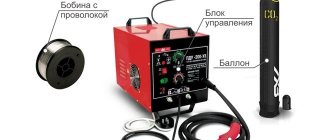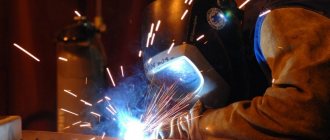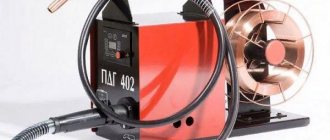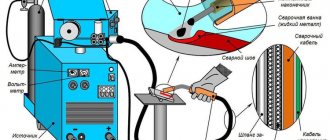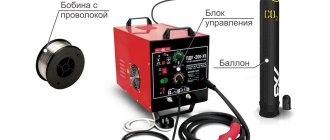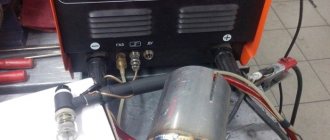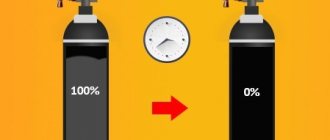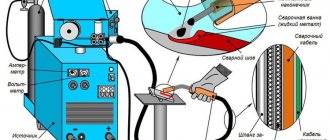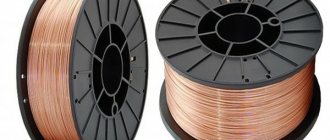What you need for welding
- Current source (semi-automatic);
- welding wire;
- shielding gas.
The welding wire must be identical to the metal being welded. In our case, choose stainless steel for a semi-automatic machine.
Stainless steel welding wire for semi-automatic machine
There is wire from Russian and foreign manufacturers on the market, which is divided into flux-cored and solid wire. Diameter from 0.13 to 6.0 mm. At home, diameters of 0.6 and 0.8 mm are used, and over 1.0 mm in production.
- Solid wire is used for gas shielded and submerged arc connections. This method eliminates the entry of air into the welding zone, thereby improving the quality of the weld.
- Corroded stainless steel wire (self-shielding) is a thin-walled tube filled with flux and gas. The mixture of components allows you to weld products without protective gases (carbon dioxide and argon).
Wire for welding stainless steel semi-automatically, produced with heat treatment or cold drawn. And it is divided into oxidized (T) and light (white, TS).
Stainless steel wire is available in 2 accuracy classes:
- increased accuracy (P);
- normal accuracy.
Wire with increased precision is used to improve the quality of the seam.
Stainless steels are divided into different grades based on their chemical composition, and the wire also has different markings. The table (below) will introduce the brands, diameter and weight of stainless steel wires:
Cost of stainless wire for semi-automatic machine
The price varies depending on the manufacturer and the region of residence of the buyer.
- ER 308 LSI 0.8mm 1kg - 825 RUR;
- ER 308 LSI 0.8mm 5kg — 4237 rub.
Video:
Gas selection
Semi-automatic cooking without gas is prohibited, except when using cored wires. Semi-automatic welding of stainless steel can be performed in an environment of carbon dioxide or a mixture of carbon dioxide and argon.
Carbon dioxide is a readily available and cheap gas for joining stainless steels. When used cleanly, the welder is faced with excessive spattering of metal and a clumsy weld.
It is more convenient to use a mixture of argon and carbon dioxide, percentage ratio 98/2 (Ar-98%, CO2-2%). Experienced welders vary the composition of the mixture depending on the brand of stainless steel and their preferences.
The percentage of carbon dioxide and argon can be adjusted using two separate cylinders. Connect the outputs from the two gearboxes using a tee taken from the windshield wiper of a domestic car. Details of this design are in the video:
That's it, all you have to do is select the shielding gas and connect the wire to the device. Be aware: the conductive tip must be the same diameter as the wire.
Buy tips with a reserve; during operation they burn out and the device then cooks worse.
Video: how to set up a semi-automatic machine for operation (for beginners).
How to weld stainless steel in a carbon dioxide environment
Use a grinder to clean the working surface of the product, and when connecting metal with a thickness of 4 mm or more, make edges (grooves for depositing metal). This article talks about marking stainless steels and preparing surfaces.
After cutting the chamfers, join the parts together using clamping pliers, leaving a gap between the products (at least 1.5 mm).
The gap should be along the entire length of the workpiece; it will allow the metal to be welded to its full thickness. Connect the ground and set your settings on a semi-automatic device depending on the design of your device and the thickness of the metal.
Simple semi-automatic machines on the front panel have 2 adjustments:
- welding voltage;
- wire feed speed.
Advanced models are equipped with an inductance adjustment knob. Also, the wire feed speed depending on the diameter can be adjusted by a switch.
Setting the inductance changes the arc rigidity, penetration depth and bead shape:
- With low inductance: the arc is cold - we get a thin bead with deep penetration;
- With high inductance: the arc is hot - a wide bead with shallow penetration.
Holding the torch with a slope of 20-60 degrees (the distance from the nozzle to the weld pool is 10-20 mm), use short tacks to make a stainless steel connection. They pulled the trigger, released it, pressed it and released it, and this is how the cut edges are slowly filled with metal. You can cook either with an angle back (toward you) or with an angle forward (away from you).
The tables (below) will help you decide on the settings of the semi-automatic machine:
When welding with an overlap, there is no need to cut chamfers; it is enough to clean the surface, place the parts on top of each other and make the connection.
During the welding process, before making a new seam, bite off the weld bead at the tip of the wire.
In the process of joining stainless steel semi-automatically in a carbon dioxide environment, change the wire feed speed, with such manipulations you will achieve a high-quality seam.
Video:
Source: plavitmetall.ru
How is stainless steel welding performed using a semi-automatic machine?
Reading time: 6 minutes
Stainless steel is used in many areas: from the production of saucepans to the assembly of spaceships. The popularity of stainless steel is due to its operational properties: the metal is practically not subject to corrosion and retains its attractive appearance for a long time. It is for this reason that welders who can qualitatively weld stainless steel parts are now in great demand.
But welding stainless steel is not so easy. Here you won’t be able to use manual arc welding and get by with coated electrodes. You will need a professional or semi-professional semi-automatic machine, as well as shielding gas and filler wire. This stainless steel welding technology is one of the most effective. It is used both at home and at work.
In this article we will describe in detail how to use a semi-automatic machine for welding stainless steel and what is the technology for welding stainless steel with a semi-automatic machine. You will learn everything you need to do quality work.
general information
Semi-automatic welding and cutting of stainless steel using shielding gas is a technology that has long established itself as one of the most optimal. This technology has the abbreviation MIG/MAG, which means “metal inert gas welding” or “metal active gas welding,” respectively.
The essence of this technology is simple: gas and welding wire are used for welding, which is continuously fed into the welding zone and forms a seam. The process creates an arc that melts the metal and allows the molten wire to mix with the workpiece to form a weld. The gas performs a protective function, preventing oxygen from entering the welding zone and oxidizing the metal.
To form a high-quality seam, it is necessary to correctly set the welding mode. A welding mode is a set of settings. Namely, the current strength, the feed rate of the filler material, the type of filler material itself, as well as the choice of gas and its optimal flow rate.
Often, a mixture of carbon dioxide and argon is used for MIG/MAG welding of stainless steel. Semi-automatic welding of stainless steel in an argon environment or semi-automatic welding of stainless steel in a pure carbon dioxide environment is rarely used. Sometimes carbon dioxide is replaced with oxygen, but this is necessary to fulfill certain technological requirements and is of little use in amateur welding.
There are three ways to weld stainless steel using MIG/MAG technology: short arc welding, jet transfer welding or pulse welding. The choice of method depends on the thickness of the metal. For thin stainless steel, the first method is suitable, for welding metal up to 3 mm thick, the jet transfer method is suitable, and pulse welding is effective when welding stainless steel with a thickness of 3 mm or more.
Advantages and disadvantages of the method
MIG/MAG welding of stainless steel has many advantages over other methods such as MMA or TIG. We will list some of them.
First of all, MIG/MAG technology is characterized by high productivity. The work is done much faster than using other technologies. At the same time, the quality of the seams remains at a decent level.
We also note that there is no large amount of smoke observed during welding. Which is very convenient when welding indoors.
The only disadvantage is the need to use a gas cylinder, which often leads to problems with transportation. You won’t be able to simply move the cylinder to the required location because its weight is too large. But this disadvantage does not exist except for MMA technology, which is of little use for welding stainless steel.
Gas selection
Working with ordinary stainless wire involves the use of shielding gas. Without it, the welded joint will oxidize, the melting metal will begin to spatter, and it will be impossible to obtain a normal seam. The following types of gas exist:
- Carbon dioxide. This is the cheapest option available. This is where the benefits end. Welding stainless steel semi-automatically in a carbon dioxide environment turns out to be quite rough. Strong splashing prevents you from laying a perfectly even seam. However, despite this fact, this option is suitable for 90% of all welding work with stainless steel.
- Argon. This gas is ideal for welding stainless steel. With appropriate welder skills, the welded joint has high strength and ideal shapes. But the high cost of gas greatly increases the price of 1 centimeter of welded joint. This option is suitable for specific work where, first of all, the appearance of the weld is important.
- Carbon dioxide + argon. The optimal option that combines all the advantages of the two previous gases. This mixture allows you to reduce the cost of one centimeter of weld and achieve high accuracy and quality of the connection. The welder chooses the gas ratio independently, based on the thickness of the material, its type and other parameters.
Materials and equipment
Let's move on to the welding itself. You will need a semi-automatic welding machine of semi-professional or professional class, filler material for welding stainless steel (the composition of the wire must be identical to the composition of the part that you will weld), a gas cylinder. This is the main thing. You will also need a metal bristle brush and a solvent such as white spirit.
If for some reason you cannot use a gas cylinder, then the gas and filler material can be replaced with cored wire. But remember that the quality of the seams will be noticeably worse.
Welding Features
There are several key features that you need to be aware of if you want to form a quality seam. We will list the most important of them.
As we said above, pure argon or pure carbon dioxide is rarely used for welding stainless steel. It is better to use a gas mixture. It should consist of 70% carbon dioxide and 30% argon.
Also pay attention to the protrusion of the filler wire relative to the torch. The optimal length of the visible part of the filler material is from 6 to 12 millimeters. When forming a seam, monitor the distance from the nozzle to the metal surface. The smaller it is, the better. It is not easy, but with frequent practice you can achieve good results. Don't skimp on gas. If there is not enough gas, the seam will be of poor quality.
We recommend setting the polarity reversed. Direct polarity is used only when using fluxes, which is not provided for in the technology we describe.
The welding angle is also important. The optimal value is from 5 to 10 degrees relative to the part. This way the seam melts well and turns out smooth. This is especially important when welding thick parts, where it is necessary to thoroughly melt the metal.
Semi-automatic stainless steel welding technology
- Content:
- Semi-automatic welding machine for stainless steel
- What gas is needed for semi-automatic welding of stainless steel
- Semi-automatic stainless steel welding technology
At the beginning of the last century, it was accidentally discovered that when a small amount of chromium is added to low-carbon steel, a metal appears with the ability to resist acid. Since then, the metal that is today known as stainless steel has appeared.
Just such a small change in the composition of steel led to a significant transformation in the properties of the material: low current conductivity and heat transfer, as well as the ability to be neutral to the effects of most known chemicals and water. But this also made it difficult to process the resulting steel.
Semi-automatic welding of stainless steel is a high-tech process, the result of which is influenced by: careful preparation, the correct choice of operating mode and consumables.
Copper-plated wire for metal welding
Unlike ordinary steel wire, copper-plated wire has a special coating of copper alloy. Its thickness is several micrometers, and its main task is to guarantee reliable contact with the part being welded. Copper-clad wire simplifies the work process and also gives the seam additional strength characteristics. The finished connection is capable of withstanding mechanical loads, shocks, sudden temperature changes, tearing forces, and high-temperature influences. Another advantage is the low amount of spatter, which reduces the cost of consumables. It also provides a higher speed of the welding process.
Semi-automatic welding machine for stainless steel
The carbon gas welding method has established itself as the most reliable and high-quality method for processing stainless steel. The method takes into account the structural features of the metal, its chemical properties and structure. Work with a semi-automatic machine is performed in three different ways. Namely:
- Short arc.
- Using jet transfer.
- Pulse welding.
Each of these methods is justified in certain situations.
Semi-automatic welding of stainless steel without gas is possible. Welding is performed without gas using a special flux-cored wire. The result is a high-quality seam. But the disadvantage of this method is that the suture material will rust over time. Therefore, when working with stainless steel, it is better to use wire made of the same material and with the supply of carbon dioxide to the weld pool. Accordingly, a semi-automatic machine for these works is required with the MIG / MAG function.
What gas is needed for semi-automatic welding of stainless steel
As already noted, the features of stainless steel welding are such that the best results are achieved through the use of gases that create a protective layer during the burning of the wire. Such a “cloud” is necessary so that oxygen does not affect the melting metal. Shielding gas allows you to improve the process of burning the wire and its adhesion to the material being processed.
When performing semi-automatic welding of stainless steel, two working gas mixtures are used.
- Argon and carbon dioxide - this composition is recommended for industrial work with stainless steel. The gas mixture improves the quality of the weld and ensures good spreadability of the molten metal. Gas ratio 98% Argon to 2% Carbon dioxide.
- In some cases, it is recommended to replace carbon dioxide with pure oxygen. This is necessary, first of all, to improve wettability at the ends of the seam being processed.
The use of a semi-automatic welding machine for stainless steel using gas allows the use of special stainless wire during work, which significantly improves the appearance and quality of the product after processing.
Semi-automatic stainless steel welding technology
The essence of the technology comes down to providing optimal conditions for welding work, taking into account the characteristics of the material being processed. Gas for semi-automatic stainless steel welding allows you to achieve minimal spattering of the molten wire and ensure protection of the stainless steel along the edges of the seam.
Each method of performing work has its own advantages and features:
- Using a short arc - semi-automatic welding of stainless steel, in a shielding gas environment, performed in this way allows you to provide the necessary conditions for welding thin sheets of material. The advantage of the short arc method is that it reduces the likelihood of burning through the stainless steel.
- With jet transfer - with this method it is recommended to use flux-cored wire without the use of gas. You will also need to use special heads for the automatic welding machine.
- Pulse method - of all the semi-automatic stainless steel welding modes, pulse is the most accurate and efficient, as it is fully controlled. The pulse method is so named because the wire is pulsed into the bath in the form of small drops. The pulse method of welding stainless steel has its advantages: there is no spatter at all, and the wire consumption is also reduced.
Features of using a semi-automatic machine
The use of a semi-automatic device has its own characteristics.
There are 3 options for performing welding work with such a unit:
- using pulse technology;
- using a short arc;
- with jet transfer.
Pulse welding creates a protective environment. For this, argon mixed with carbon dioxide is used.
The short arc technique is used to weld thin sheets of steel. In this case, the risks of burning the material are minimal.
The string transfer technique is intended for welding thick structural elements. It is used in production. To connect the workpieces, special heads and flux-cored wire are used.
How to cook stainless steel semi-automatically in a carbon dioxide environment: video, tips
Welding stainless steel with a semi-automatic machine can be quite difficult not only for a beginner, but also for an experienced specialist. Such difficulties are primarily associated with the characteristics of the metal itself, for high-quality welding of which it is necessary to correctly select the operating welding modes and the appropriate consumables.
Semi-automatic welding machine for metal welding in a protective gas environment
Advantages and disadvantages
The undoubted advantages of semi-automatic welding of stainless steel:
- High performance combined with high-quality connection;
- low smoke emission, which protects health and the environment;
- slight metal spattering due to automatic wire feeding;
- versatility - you can weld workpieces of different thicknesses, as well as dissimilar metals.
One significant drawback is the bulky gas cylinder. These are additional costs for its acquisition and inconvenient movement.
The spread of the method became possible with the development of technology and process automation. Mainly used in industry for large-scale production. Working with a semi-automatic welding machine, although it requires certain knowledge and skills, still remains one of the popular types of metal processing. You can learn more about how to operate a semi-automatic welding machine in our article.
Types of stainless steels
The main alloying element of steels classified as stainless steels is chromium. It is thanks to this element, which stainless steel must contain at least 12%, that an oxide film is created on its surface. Despite the very small thickness of such a film, sometimes not exceeding the size of several atoms, it provides reliable protection of the metal from corrosion. In addition, if this protective film is accidentally or intentionally damaged by mechanical force, then after some time it will restore its integrity.
The chemical composition of the vast majority of stainless steel grades, in addition to iron, carbon and chromium, may contain chemical elements such as nickel, titanium, niobium and molybdenum. These elements, found in stainless steel in fairly small quantities, improve both the anti-corrosion and mechanical characteristics of the alloy.
Chemical composition of the main grades of stainless steel
Stainless steels, depending on the characteristics of their internal structure, can belong to one of the following types.
These are alloys containing 17% chromium and 0.5% carbon. Stainless steel with this structure is hard and highly brittle and can only be successfully used in slightly aggressive environments.
The chemical composition of such steels, in addition to chromium and carbon, also contains nickel, which increases the austenitic region in their structure. The distinctive qualities of such alloys, classified as non-magnetic, are high corrosion resistance and strength, optimally combined with good ductility.
This includes stainless steel alloys containing no more than 0.12% carbon and up to 30% chromium. This stainless steel, characterized by a good ratio of high strength and ductility, is resistant to thermal hardening and can be successfully used in conditions of exposure to aggressive environments.
Semi-automatic welding of stainless steel in a protective environment ensures high-quality connection of products
Characteristics
When welding stainless steels, it is important to use a welding wire that contains the same components as the base metal . This is the main condition for obtaining a high-quality seam. Chemical composition is the main indicator.
The wire manufacturing technology provides high physical and mechanical properties . They are not inferior to the same characteristics as the base metal.
When using stainless wire as surfacing, it is important to know the deposition rate. With its help, you can calculate the required amount of consumables and select the optimal current value.
Properties and weldability of stainless steel
Steels classified as stainless steels are difficult to weld materials, which is explained by a number of their physical and chemical characteristics. When you decide to cook stainless steel with a semi-automatic machine, you must take into account a number of important parameters. Only in this case can you count on the resulting welded joint being of the required quality and reliability.
Compared to steels of other categories, stainless steel has a fairly low (on average two times) thermal conductivity. Because of this, heat is removed from the welding zone very poorly, as a result of which the metal is subjected to significant overheating, which negatively affects its corrosion resistance. To avoid such negative consequences, welding of stainless steel using a semi-automatic machine is performed at a reduced current (by 15–20%), and the parts to be joined are subjected to additional cooling.
Approximate modes of semi-automatic welding in a shielding gas environment
With significant heating (over 500°), carbide compounds are formed at the boundaries of the crystal lattice of stainless metal, which cause a phenomenon such as intergranular corrosion. As a result, delamination of the internal structure of the metal occurs and corrosion processes develop. To avoid this, they resort to more intensive cooling of the products being joined, for which ordinary water can be used.
It is also difficult to cook stainless steel (including in a protective gas environment) because it has a tendency to thermal expansion. Significant expansion of the joined products that occurs during semi-automatic welding leads to the formation of cracks both in the weld and in the base metal. Meanwhile, this phenomenon can be avoided if a wider gap is left between the parts being welded.
A high-quality stainless steel weld may be slightly grayish, but not dark
Stainless steel, due to the characteristics of its chemical composition, has a fairly high electrical resistance, which causes significant heating of the electrodes used for semi-automatic welding. In this regard, for welding stainless steel, electrodes made of wire with a certain chemical composition are used, and the length of the rods, if they contain chromium and nickel, should not exceed 350 mm.
How to cook stainless steel yourself using a semi-automatic machine?
Stainless steels are subjected to welding quite often; this process requires care. Before you start cooking stainless steel, you need to read the process instructions and the features of using the burner.
The semi-automatic welding scheme for stainless steel is simple, although compliance with all standards and conditions is required. For welding, a special wire is used, which contains nickel, which improves the characteristics of the seam.
Welding process diagram.
The welding torch itself and the work diagram are:
- the burner body, which must be tilted at a certain angle;
- a nozzle, which must be at a strictly defined angle and at an optimal distance so that the seam heats up perfectly;
- a conductive tip located inside the nozzle;
- electrode welding wire inserted into the conductive tip;
- welding arc acting on metal;
- the weld seam that remains after the process of welding parts;
- weld pool, i.e. an area of molten metal that is formed under the influence of high temperatures;
- electrode drops that are fed into the bath;
- gas protection.
Semi-automatic welding techniques
Melt and transfer of electrode material: A. Drop method. B. Jet method.
Welding stainless steel is possible in several ways:
- pulse welding;
- welding using a short arc;
- welding, during which so-called jet transfer is used.
A short arc is used when the work is done on thin metal. Using jet transfer is effective for joining thick parts. Pulse welding technology is a controlled process.
The metal for the wire is introduced into the bath in pulses, and the supply is carried out one drop at a time.
The arc operates at an average current level, heat input is reduced, as is the overall thermal effect zone. The size of the weld pool is optimal, and this is important for stainless steel.
With pulse technology, there is also almost no splash of molten metal. This saves materials and the process itself is safer.
The time for cleaning the seam is reduced, and the surface is of high quality.
Is it possible to weld ferrous metal and stainless steel? Yes, such a process is possible, but only if certain conditions are met. It is necessary to take into account why stainless steel is used and what kind of ferrous metal will be used.
It is important to choose the right filler wire; you should not use the usual one, as the quality of the weld will be poor. When using an arc and an argon mixture, special stainless steel additives are required.
How to create a landscape design yourself and beautifully?
Semi-automatic welding technology in a protected environment
To answer the question of how to semi-automatically weld stainless steel, it is necessary to clearly define all the requirements for such a process.
Preparatory work:
Gas shielded welding diagram.
- The gas for welding is taken with the following composition: 70% special welding carbon dioxide (you can use food grade carbon dioxide), 30% argon B.
- Reverse polarity is applicable during operation. Straight polarity is only possible when working under flux.
- The welding wire overhang should be 6-12 mm. When welding, the distance from the nozzle should be 5-15 mm. The working flow rate of the gas welding mixture will be 6-12 m³/min while maintaining a pressure of 0.05-0.2 atmospheres. It is impossible to reduce the amount of gas, since in this case the seam will be insufficient and its quality will be poor. A situation is also possible in which carbon begins to burn out strongly, as do alloying additives.
- The welding angle must be maintained so that it faces backwards. It is recommended to tilt the electrode in the direction opposite to the direction of the seam. The tilt is maintained at 5-10 degrees. This gives a good penetration depth, the seam is of better quality and smoother. If the angle is tilted forward, the seam becomes wide and the penetration depth is shallower. The latter option is best suited for thin metal.
- During the welding process it is necessary to use a desiccant. This is required for the reason that the composition of the cylinder consists of 60% water; upon exiting at the seam, acid is formed under the influence of high temperature and carbon dioxide. But this acid greatly worsens the quality of the seam, and a desiccant can solve this problem. It uses silica gel or copper sulfate, which are calcined at a temperature of 200°C in about 15 minutes. For 3-4 working volumes of cylinders you need to take only 100 g of such a desiccant.
- It is required to provide protection from metal splashes. Usually it is recommended to use a chalk aqueous solution for this.
Welding Process Basics
The special stainless steel welding wire itself is an electrode, which simplifies the welding process.
Stainless steels are available in 3 grades; the welding process will greatly depend on the choice of this grade:
- food grade stainless steel, low alloy;
- food grade, chemical stainless steel, medium alloy;
- heat-resistant, high-pressure-resistant, chemical-grade stainless steel, high-alloy.
To cook with a semi-automatic machine correctly, you need to use a special wire:
- The first two types of such welding wire ensure the mixing of all alloying elements during welding, but the metal burns out, especially chromium. A process called corrosion occurs when aggressive environments occur.
- The third type of welding wire is special; during welding, no cracks or stresses are formed in the seam, i.e. the joint is of high quality.
Preparatory work for metal:
- The surface of the parts to be welded must be degreased and all traces of the oxide film must be completely removed. This is done mechanically or using special acids.
- Before welding itself, it is necessary to dehydrate the future seam, for which it is heated to 100°C with a torch. But during welding, all remaining excess boils away automatically, especially if a continuous seam is made.
- There is a preparation option in which the area of metal around the future weld is heated to 200°C; in some cases, this procedure is carried out for the entire workpiece. This allows you to reduce the impact on the metal near the seam during its heating during welding.
- It is not recommended to heat 2 different types of steel, only one type.
For the sides, it is best to overlap with welding on both sides; the edges themselves can be bent outward, the inner corner is not welded. The outer edges are often processed using rollers using the pressing method.
How to relieve tension?
When welding semi-automatically, it is important to relieve stress from the metal; the following actions are used:
- The stress is removed during tempering at 560-660°C. This process involves heating the part to be welded to the required temperature, after which the part itself is cooled in the open air.
- If a temperature of 760°C is reached, then a process such as the reduction of chromium on the weld is observed. This allows stress to be quickly relieved to ensure the required weld quality.
- For thin-walled parts, stress is perfectly relieved. If you start piercing the seam with hammers after welding, then the operating temperature is maintained at only 100°C.
Straightening deformities
After welding is completed, it is necessary to perform the following actions aimed at removing possible deformations:
- Using a special smoother, a hammer is used to process the part, which should fit tightly to the anvil.
- If a bubble has formed on the surface, then you need to tap it along the edge with a hammer, carefully approaching the bubble itself. On the other hand, this area can also be heated with a burner, moving in a circle of 30-60 mm. You just need to move in a checkerboard pattern and don’t stop tapping with the hammer.
Welding stainless steel semi-automatically requires certain skills. The process itself includes preparing the welding area and wire for work. After welding, if necessary, work is performed to eliminate deformations.
Consumables
Good results in joining stainless steel parts can be achieved by welding performed in a shielding gas environment. To weld using this technology, naturally, you will need both special equipment and appropriate consumables, which are filler wire and the gas itself.
The purpose of gas in semi-automatic welding is to protect the molten metal in the weld pool from oxidation. The gas used for such protection should not itself react with the molten metal so as not to have a harmful effect on it. That is why inert argon mixed with a small amount of carbon dioxide is predominantly used as a protective medium.
On the left is a weld made in a carbon dioxide environment. On the right - in argon (98%)
The standard composition of the gas mixture used when welding stainless steel with a semi-automatic machine includes 98% argon and 2% carbon dioxide. In some cases, in order to reduce the cost of welding, it is possible to use a gas mixture consisting of 70% argon and 30% carbon dioxide.
To weld stainless steel while obtaining a high-quality and reliable weld, it is very important to choose the right filler wire, which should also be made of stainless steel. In cases where it is not possible to use shielding gas, semi-automatic welding is carried out in a normal environment, but special flux-cored wire is used to perform it. Meanwhile, the use of the latter leads to the fact that the welds may become covered with a layer of rust over time.
Which protection is better?
When performing semi-automatic welding, you can use 3 protection options: argon environment, carbon dioxide, argon with carbon dioxide.
Argon environment
When using such protection, welding seams are more aesthetically pleasing. But during operation there is intense emission of molten metal and the arc is unstable. However, argon arc welding is quite expensive.
We recommend reading: How to weld stainless steel with electrodes
Carbon dioxide
This is the most economical option for welding stainless metal with a semi-automatic machine. But there is even more splashing than with argon protection. This results in rough seams.
The best option is a mixture of these components in a proportion of 95%/5% or 98%/2%, respectively, argon and carbon dioxide. This makes it possible to reduce the cost of welding work without compromising the quality of the connection. And if high demands are not placed on the seam, you can increase the percentage of carbon dioxide to 30%.
We recommend that you read
What gas is needed for a semi-automatic machine?
Some features of the technology
The use of special semi-automatic welding machines mentioned above can significantly improve the quality of stainless steel welding, as well as simplify the process of its implementation. The use of such equipment allows you to solve several technological problems at once, including:
- supply of filler wire to the joint formation zone;
- supply of shielding gas to the welding zone;
- cooling of the welding torch;
- ensuring the convenience of making welded joints in hard-to-reach places.
Semi-automatic welding equipment
In products made of stainless steels, during the welding process, significant internal stresses are formed, which are removed by their further heat treatment - heating to a temperature of 660–760° and slow cooling in the open air.
Preparation for welding work
Before welding products made from stainless steel using a semi-automatic machine, they must be properly prepared in order to obtain a high-quality and reliable connection. The process of such preparation is as follows.
- The surface of the parts to be joined is thoroughly cleaned using a metal brush and then degreased, for which the most common solvents can be used.
- To remove residual moisture from the surface of the product, it is heated to a temperature of 100°.
Preparing stainless steel for welding the manifold
Welding rules and methods
As mentioned above, in order to qualitatively weld stainless steel using a semi-automatic machine, it is necessary to correctly select the filler wire from which the weld will be formed. It is optimal if the degree of alloying of the wire exceeds that of the base metal. This is explained by the fact that alloying elements contained in the chemical composition of the wire will burn out of the metal during its melting, therefore their content must be taken into account with a reserve.
Steel wire for welding
It is made from carbon or low-alloy steels and is distinguished by its versatility. It is used for welding various metal structures, metal parts and products. This wire is excellent for creating permanent connections during construction, installation, and production work. Welding is performed under submerged arc without the use of shielding or inert gas. Automatic or semi-automatic devices can be used as equipment. General purpose welding wire used for welding steel usually contains a certain amount of alloying elements. They improve the welding process, protect the seam from corrosion, allow you to stabilize the arc, and also solve other technological problems. Manganese, chromium, silicon and nickel are usually added as alloying elements.
Semi-automatic welding of stainless steel - instructions from professionals
Semi-automatic welding of stainless metals
Content:
- Method of semi-automatic welding of stainless metals - what is it.
- Equipment and consumables.
- Semi-automatic welding of stainless steel with other types of metals.
- Recommendations and nuances.
- Treatment of stainless steel after welding.
- Is shielding gas needed when semi-automatically welding stainless steel?
- Advantages and disadvantages compared to other welding methods.
Method of semi-automatic welding of stainless metals - what is it
The modern MIG/MAG semi-automatic process for welding stainless steels using shielding gas involves the automatic supply of filler material to the welding zone.
The filler wire begins to melt under the influence of the arc, forming a weld together with the stainless metal. To achieve higher quality welding of stainless steels, a pulsed mode is used. Semi-automatic pulse welding allows you to achieve complete control over heat input and the formation of a high-quality weld with an optimal penetration depth, as well as eliminate warping and deformation of the product. In addition, it is necessary to correctly perform all the inverter settings, select the filler material and select the shielding gas. With semi-automatic MIG/MAG welding of stainless metals, a high speed of weld formation with optimal penetration depth and a beautiful shape of the weld joint is achieved.
Semi-automatic welding of stainless metals can be performed using three methods:
- short arc – for welding stainless steel up to 0.8 millimeters thick;
- jet arc - for welding products with a thickness of 0.8 to 3 millimeters;
- pulse welding mode - for welding stainless steel of different sections - the most effective method that allows you to achieve high-quality penetration with controlled heat input.
Equipment and consumables
- semi-automatic inverter with pulse welding mode, for example;
- filler wire of the required cross-section, which is identical in composition to the metal being welded;
- gas cylinder (mainly a mixture of argon and carbon dioxide);
- materials for processing and preparing the product before and after welding.
| Metal thickness, mm | Wire cross-section, mm | Current strength, Ampere |
| 1 | 0,8 | 65 |
| 1,5 | 0,8 | 115 |
| 2 | 0,8 | 130 |
| 3 | 1 | 215 |
| 3 | 1 | 210 |
| 4 | 1 | 220 |
| 4 | 1,2 | 280 |
| 5 | 1,2 | 300 |
| 5 | 1,2 | 190 |
| 6 | 1,2 | 300 |
| 6 | 1 | 115 |
| 8 | 1,2 | 300 |
| 8 | 1 | 130 |
| 10 | 1,2 | 300 |
Setting up a semi-automatic machine
To obtain a strong connection between parts, you need to correctly configure the operating mode of the welding equipment.
When choosing options, consider the following information:
- thickness of the workpieces (the thicker the product, the higher the values of welding voltage and current are set);
- connection method (vertical, butt, corner);
- wire cross-section (the choice of this parameter depends on the set voltage and current values);
- the size of the gap between the structural elements being welded.
For example, when making a tight butt joint between workpieces 0.8 mm thick, 0.8 mm electrodes are used, voltage up to 16 V, current 50-80 A.
Semi-automatic welding of stainless steel with other types of metals
- welding with ferrous metals - the fluidity of the metal is reduced, the working surface is protected from exposure to the atmosphere;
- when welding St40 grade metals with stainless steel, 08G2S wire is used, which eliminates the deformation of the seam (rupture) along the border with the ferrous metal during cooling;
- when welding copper with stainless steel, low-melting solders and flux are used;
- the pulse mode of welding stainless steel with aluminum and other metals allows one to achieve good corrosion resistance, high-quality penetration with controlled heat input;
- It is recommended to weld aluminum with stainless steel in a pulsed mode in an argon environment using copper-cored wire.
Recommendations and nuances
- Sometimes stainless steel welding is performed in the Double Pulse mode - double pulse. In this mode, two pulses (low and high) are superimposed on the welding base current. During a high pulse, highly efficient welding is achieved, and during a period of low pulse, the metal cools down, eliminating the formation of smudges and warping. During a high pulse period, the welding drop is “driven” into the melt zone, without causing short circuits, and during a low period, the metal cools, eliminating the formation of sagging and smudges. . In the Double Pulse mode, ideal heat transfer between the melting filler material and the stainless steel bath is achieved, and the quality of the weld is improved. The “Double Pulse” mode is implemented in the TRITON ALUMIG 250P Dpulse Synergic device.
- Welding is carried out with reverse polarity. Welding with direct polarity is carried out only using submerged arcs.
- A mixture of carbon dioxide and argon is used as a shielding gas.
- The filler wire overhang should be within 6-12 millimeters. Adjust the average flow rate of the gas mixture within 6-12 m³/min.
- Welding is carried out with the torch angled backwards to achieve deep penetration and the correct shape of the seam. Forward angle welding is used for thin sheet metals when a shallow penetration depth is required with a wide weld shape.
By following the recommendations described above and the correct settings of the inverter semi-automatic machine, you can achieve high-quality welding of stainless steel products.

